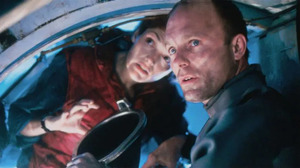The Abyss

Born and raised in Ontario, Canada, James Cameron developed an early fascination with science fiction, technology, and storytelling – a trio of passions that would go on to define his distinctive directorial voice. After relocating to California as a teenager, he initially pursued physics before shifting his focus to filmmaking. He began behind the scenes, working as a model maker and visual effects artist on low-budget productions. Though his early roles in the industry were humble, they provided a deep technical grounding and an intimate understanding of film mechanics that would later set him apart from many of his contemporaries.
Cameron’s breakthrough came with The Terminator (1984), a taut, high-concept sci-fi thriller that thrust him into the spotlight. The film displayed his talent for blending propulsive action with innovative practical effects and layered, iconic characters. He followed with Aliens (1986), an ambitious sequel that expanded on the original’s mythology while injecting emotional gravity and relentless suspense. The result was a visually commanding, narratively precise, and character-driven masterclass in blockbuster filmmaking. With these back-to-back successes, Cameron established himself as a filmmaker capable of merging technical boldness with emotional depth – renowned for his kinetic action sequences, strong female leads, and thematic focus on endurance, sacrifice, and redemption.
After delivering two commercially and critically triumphant action films, Cameron turned his attention to a more introspective and technically demanding project – one that would explore profound philosophical questions while pushing the limits of cinematic innovation. Long intrigued by the mysteries of the deep sea, he saw the ocean as an ideal setting to explore human vulnerability, fear, and the possibility of transformation – both personal and collective. The Abyss would mark a shift in tone and ambition, allowing Cameron to dial back the relentless pacing of his earlier work and tell a more emotionally resonant story.
The Abyss begins with a maritime disaster: a U.S. nuclear submarine mysteriously sinks after contact with an unidentified object, prompting the military to enlist a civilian oil rig crew to aid in the recovery. Rig foreman Bud Brigman and his estranged wife Lindsey – the engineer and designer of the advanced underwater drilling station – become central figures, with their fractured relationship serving as the film’s emotional spine. Complicating matters, a Navy SEAL team led by the increasingly unstable Lieutenant Hiram Coffey arrives to secure a warhead from the wreck before it can fall into the hands of the Soviet Union.
Unable to disconnect from their support ship in time due to the conflicting agenda of the SEAL team, the crew find themselves caught in a fierce storm. The storm causes a crane from the ship to collapse, dragging the entire platform to the edge of an oceanic trench. With the rig flooding and its power systems damaged, the team is left stranded, isolated in the depths. Unable to restore communications, they are forced to wait out the storm. It is in this claustrophobic environment that they unexpectedly encounter something far more mysterious – a non-terrestrial intelligent presence known as an NTI.
The crew’s first encounter with the NTIs is a moment of awe tinged with unease. The beings begin to manipulate the surrounding water into fluid, organic shapes that hint at their intelligence and intent. The now-famous water tentacle that is created to represent their method of communication is a stunning visual effect – an ingenious blend of computer-generated imagery and practical effects – and a landmark moment in film history. Visually striking and emotionally resonant, the beautiful and unsettling depiction of the manipulated water conveys the NTIs’ immense power and their capacity for communication rather than destruction, embodying both wonder and restraint.
As the tension rises, the crew becomes splintered. Coffey, descending into paranoia from the effects of high-pressure-nervous-syndrome, prepares to attack the NTIs, while Bud and Lindsay fight to establish peaceful contact. Bud ultimately undertakes a harrowing solo descent into the trench to disarm the warhead and prevent catastrophe. In doing so, he confronts not just the unknown, but his own internal fears and limitations. The climax arrives with a symbolic act of salvation: the NTIs rescue the crew from certain death, raising their ship to the ocean’s surface with the drilling platform and its crew resting safely atop its hull.
At its core, The Abyss is a powerful critique of humanity’s instinctive fear of the unknown and the paths we choose to take in response – whether through aggression and control, or empathy and connection. The film argues that, in the end, survival and progress depend not on domination, but on the willingness to engage openly with what exists beyond our understanding. Cameron’s message is ultimately deeply personal: a sobering reflection on the consequences of our tendency to escalate conflict in the face of fear, rather than seeking clarity and reconciliation, especially when confronting forces that are seemingly beyond our grasp.
The production of The Abyss was itself a trial by water. Infamous for its punishing demands, it was a perfect storm of technical challenges, grueling conditions, and creative clashes that pushed the cast and crew to their emotional and physical breaking point. Cameron’s relentless perfectionism resulted in an exhausting shoot, with underwater filming in massive tanks requiring constant improvisation, and the development of revolutionary visual effects which marked a turning point in CGI but took a toll that was immense. The resulting film is a testament to the lengths the director would go in pursuit of his vision, and a cautionary tale about the cost of creative ambition.
Though The Abyss underperformed at the box office – earning approximately $90 million against an estimated $70 million budget – its legacy has only grown since its theatrical release, standing today as one of Cameron’s most daring and innovative works. The NTI sequence alone remains a milestone in digital effects, and the film’s exploration of fear, reconciliation, and the fragility of the human condition continues to captivate audiences. In the arc of Cameron’s directorial career, The Abyss represents a bold and soulful detour – a technically masterful, thematically rich meditation on what lies beneath.

